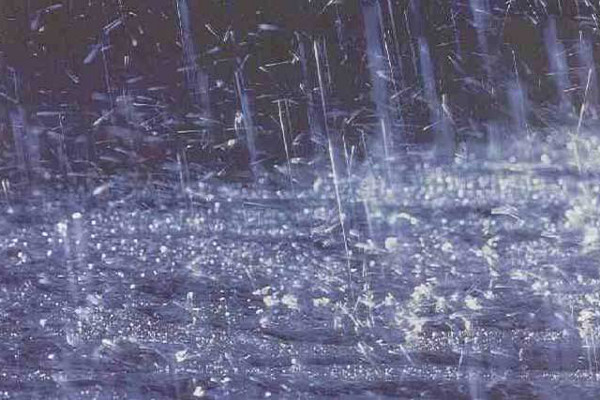“If you only do one thing, collect rainwater.” – Bill Mollison
Contents
What is rainwater harvesting?
Rainwater harvesting is simply the collection of water for domestic or commercial use that would otherwise go down the drain. Various techniques have been practised for thousands of years to collect and store water, especially in areas of low rainfall. Today, rainwater harvesting systems can be installed in both new and existing buildings and can range from a quick, cheap, water butt to a more complex system involving underground tanks and pumps.

Rainwater can be used for watering the garden, washing the car, showering, flushing the toilet, the washing machine, and even drinking if treated with UV light. The quality of the water, if stored and collected correctly, will not pose a health risk when used for these functions.
Water butt
The simplest collection method is a rainwater butt connected via a diverter (see below) to a downpipe from the roof – water collected can be used on the garden, via a hose or watering can.

Source: Met Office.
Rain harvesting system
In a typical rainwater system water is collected from the roof and taken via pipes to a storage tank. A filter removes leaves and other debris and a settlement tank allows small particles to sink to the bottom; floating debris is skimmed off the surface via an overflow pipe, and clean, oxygenated water extracted from just below the surface. Water can be pumped directly from the tank to appliances or can be pumped to a header tank sited in loft space. The header tank system is the more reliable though water pressure will be lower and the system will cost more. Most systems will automatically switch to mains water to top up the tank when rainfall is low.
Drinking water
Rainwater can be used for drinking if you install a UV sterilisation unit; the unit is switched on permanently and uses c. 40 watts. This unit will need two filters before the water reaches it – 25 and 5 microns, otherwise micro-organisms can ‘hide’ behind particles.
What are the benefits of rainwater harvesting?
Rainwater harvesting reduces the strain on groundwater or river system water sources. Wells, boreholes and aquifers are drying up at an alarming rate and rivers frequently run dry or very low in the summer months. In some parts of the country, notably the south-east, population rise and extensive house-building are increasing the pressure on an already scarce resource. The Environment Agency reported that a rising population in the UK will increase demand for water, but changing weather patterns will mean drier summers and winters, with short periods of intense rainfall, which will need to be diverted out to sea quickly, to prevent flooding. This will seriously curtail water available for domestic and commercial use. The EA predict a reduction of 10-15% in available water supply, and reduction in river levels of up to 80%. An estimated 66% of domestic water needs could be provided directly from rainwater: 25% of the water we use is for flushing the toilet, 22% for washing car, clothes etc, 33% for personal washing and 6% for the garden.

Only about 4% of mains water is used for consumption, although all of it is brought up to that level, requiring extra filtration / chlorination etc. Rainwater use reduces the need for mains purified and chlorinated water (plus the pumping, energy use, pollution and CO2 emissions that go with it), and has the added bonus of being soft water and so does not clog up pipes or leave deposits in the kettle as hard water does. Washing clothes in soft water requires less detergent and so reduces water pollution from these compounds. Plants thrive on rainwater.
Rainwater collection is not only available to the domestic user but also to industrial, commercial and agricultural users. Large scale collection of rainwater can reduce run-off and so the risk of flooding and flood damage.
Rainwater systems are easy and cheap to maintain, partly as the water does not require treatment.

What can I do?
First, cut your water use: average UK per capita domestic water use is around 55m³/year (160 litres / day). This can easily be cut to less than 30m³/year by installing low-flush toilets (or better still, compost loos), fixing dripping taps, washing the car less often, having showers instead of baths (especially if you share with a friend) and installing spray taps and shower-head flow regulators. It’s worth getting in touch with your local water company to establish their policies regarding rainwater harvesting and savings you can make on water and waste charges.

Source: Environment Agency.
Consider your needs against the cost of installation and environmental benefits. Suppliers claim financial savings of up to 14%, though on a domestic scale the payback time will be lengthy compared to large-scale systems. Also, note that some roofing materials may contaminate rainwater – such as bitumen-coated roofs.
Find the rainfall figures for your area (see Table 1) and your roof area, and check Table 2 to see how much water (in m³) you can expect to collect per year. For an average property with average rainfall, you should be able to get around 100m³. Check your water bills for the price you pay per cubic metre, and do the sums.

Maybe rainwater harvesting is something you want to do regardless of length of payback time, but in certain circumstances, it could be quite a cost-effective thing to do. If you can house a 2m³ storage tank in a garage or cellar, you won’t need a submersible pump, and you could buy your kit for around £1000. Then if you are handy with plumbing you could install yourself. Otherwise your tank will be underground and costs will be around £1500 for the system and £1000 for installation.
Some routine maintenance is required, such as cleaning the filters three times a year, keeping gutters clear, and checking everything once a year to see if it is working properly. Decide if you want the water from your tank to be pumped to your loft tank or direct to your appliances (cheaper) – seek advice from suppliers / installers.
Currently there are no UK regulations concerning rainwater use and water quality for washing machines, toilet and gardens, though the back-up to the mains must be in accord with standard regulations.
If you are far from mains water, or don’t fancy chlorine or fluorine in your drinking water, a UV unit costs around £500, and you have to change the bulb each year (c. £40).
Specialist(s)
The specialist(s) below will respond to queries on this topic. Please comment in the box at the bottom of the page.

Terry Nash is a Director of the UK Rainwater Management Association, a trade organisation that promotes the use of water re-use to help avoid future flood and drought risks.



9 Comments
I need to find trainin for about 50 housing maintenance engineers in grey/rain water harvesting systems both for installation and maintenance, most based around north London. Can anyone halp please. Thanks
I use a dehumidifier in my damp cellar – any ideas how best to use the resultant by-product?
For the roof collection, is any surface preferred over another in terms of water run-off cleanliness? For my own project I am thinking of either slate or corrugated steel sheet (which appears to be in all cases plastic coated).
Hi Andrew, Yes the quantity of water harvested will vary according to the collection surface; contact me via the UKRMA website if you need further information on the associated calculation.
Thank you Terry,
I’ve just enquired about the cost of mains water connection to the building that I am considering a rainwater harvesting system for. It is £1200 for admin, apart from one site visit to make the connection. The cost also excludes all physical groundwork which I estimate will be another £1300 on top since it will involve boring under a single-track road, all for the privilege of being secured onto their billing system…when clean water falls from the sky.
Does the UV bulb need to be operational all the time or is it just when water is drawn out through the tap? I assume that there will also need to be a small pump. I wonder how Building Control will view a rainwater harvesting system operated on small-scale renewables battery power?
Another thing: I’ve also watched the video where someone uses sterilising tablets rather than UV. Is a UV system mandatory to get past Building Control in the UK or are there other non-electricity dependent options that are acceptable?
Thanks,
Andrew
Hi Andrew,
RWH is aimed at non-potable applications.
Use of harvested rainwater for potable purposes is generally not recommended, but where it is the only option, you need to bear in mind:
* Private Water-supply Regulations will apply
* Harvesting potential will usually not provide sufficient water to meet both potable & non-potable needs
* The resource cannot be relied-upon during long dry spells
* Before potable use, the water will need to pass through both a carbon and a UV filter
* Your Local Authority will need to test the water, and certify it as being safe for potable use, and will want to check it regularly (at your cost)
* System costs are likely to exceed the mains connection costs suggested above
Contact me via the UKRMA website if you require more information
Hi Terry,
I am wanting to use RWH for a corner of a field where I plan to site a shepherd hut with no mains water, so need potable water as well as grey water. Use is not full time, ie its a secondary home, rewilding base using long drop composting toilet.
I have read your comments and been on CATs site, stating similarly that potable is tricky due to costs and hassle of maintenance and checks from local authority….
I have thought about having a separate potable water delivery…no idea of costs… then the RWH would just be for non potable uses….any info., ideas re this appreciated.
So looking for a good water tank and guttering supplier, or a small scale RWH installer would be good,
Many thanks in advance,
S. Kinnear
Hi Susan,
Apologies for this belated response.
Using the harvested rainwater for non-potable use is probably the best solution in the situation you describe, particularly if there is no electricity supply to the hut which would be needed to bring it up to potable standard.
Details of the suppliers of suitable systems can be found at https://ukrma.org/domestic-rwh-systems/
Kind regards,
Terry
Hey! Is it cool if I share this article with my cousin so he can get the right device or equipment in no time? It’s been raining in his neighborhood since last weekend and he wants to turn the rainwater into usable sources. Hence, I love it when you said that rainwater harvesting may result in less reliance on groundwater supplies which makes our soil even more stable. https://www.acelectric.com.au/filtration